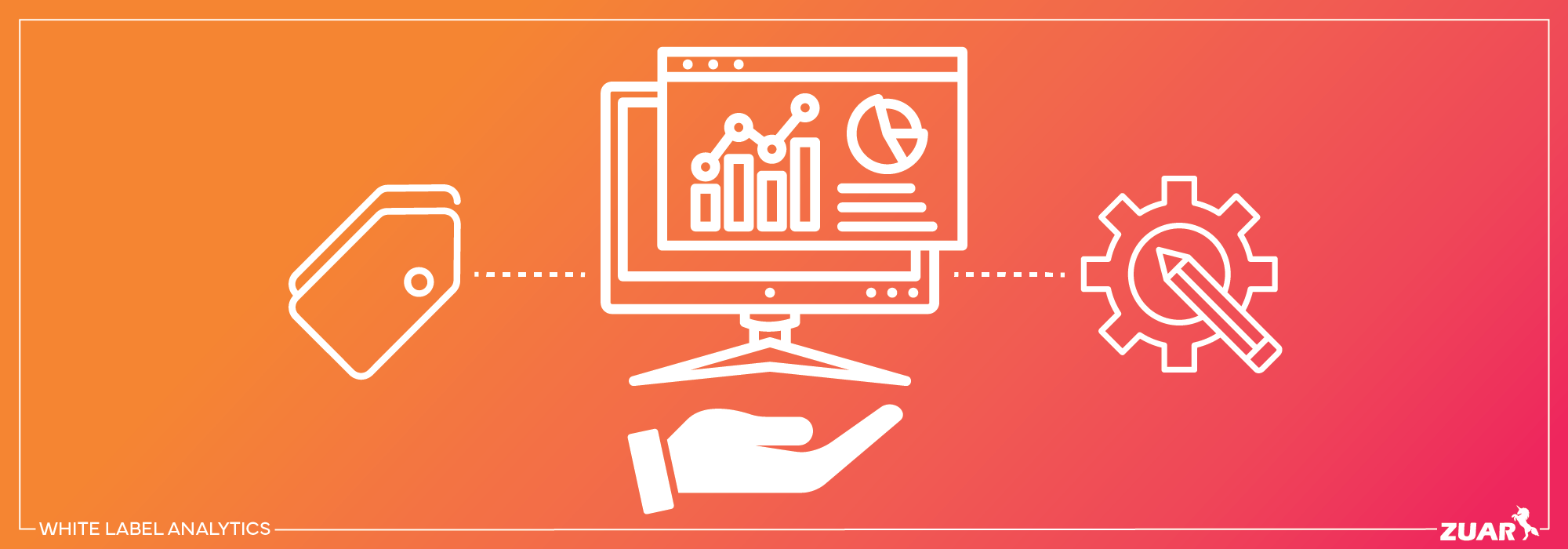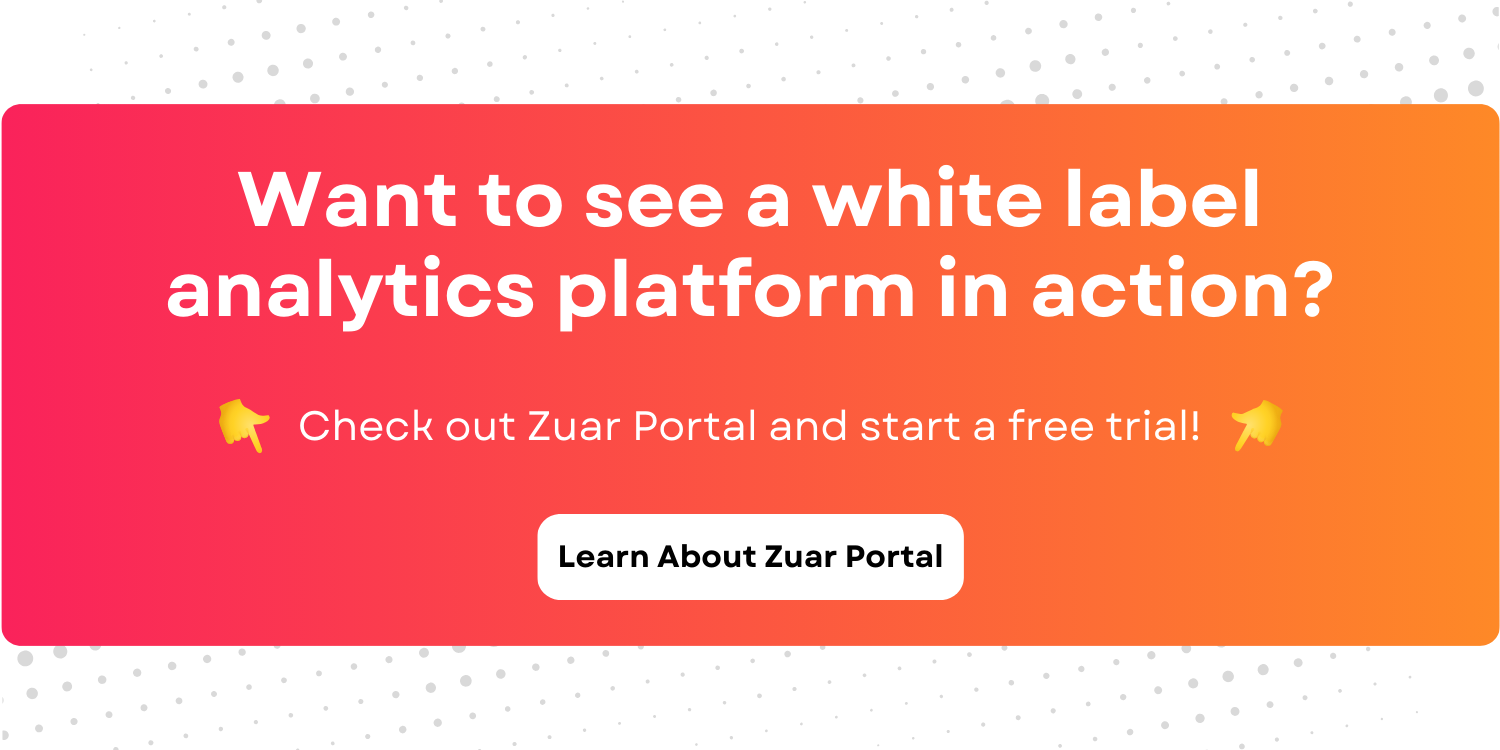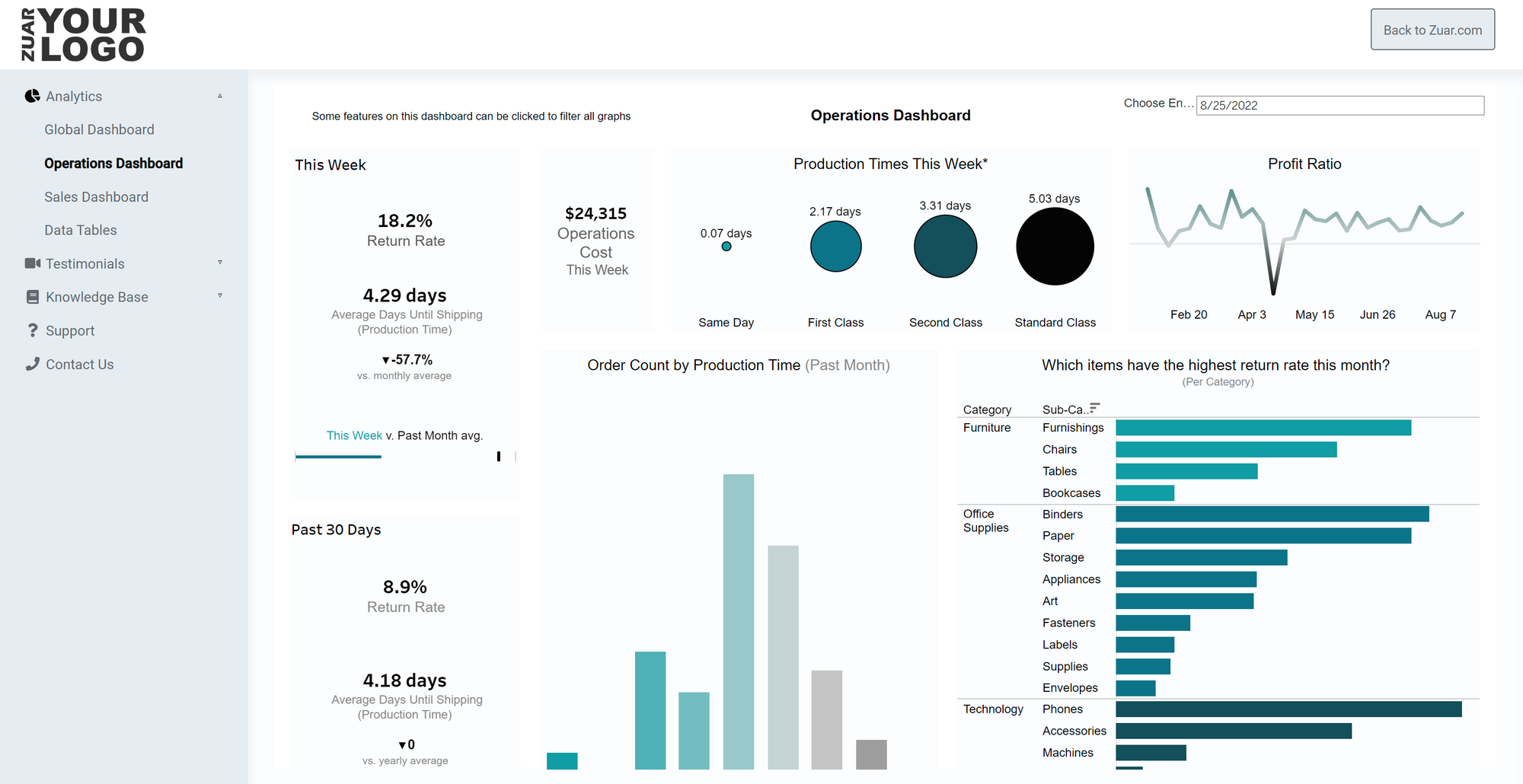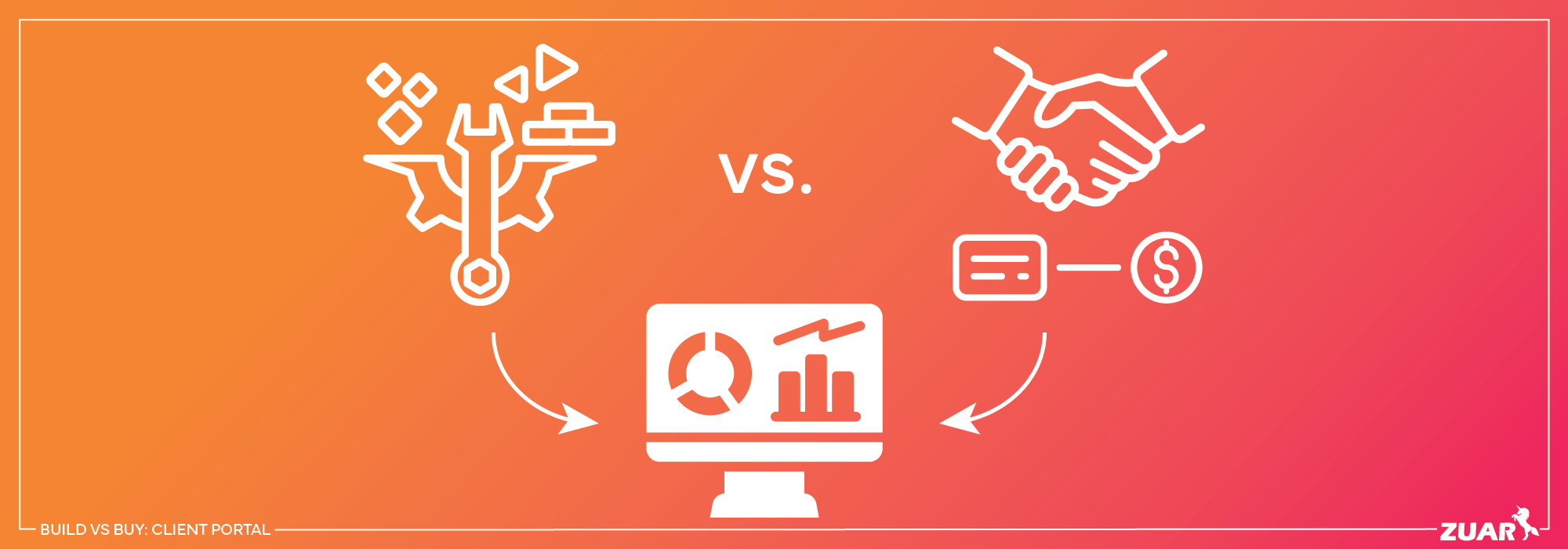What Is White Label Analytics? Benefits, Case Study & More
Learn how white label analytics enables businesses to quickly deliver branded, customizable analytics solutions to clients without the need for in-house development.

Introduction to White Label Analytics
White label analytics refers to the practice of rebranding and reselling analytics software or services under a company's own brand.
It allows businesses to offer analytics solutions, such as a client portal, to their customers without having to develop the underlying technology themselves.
In a white label arrangement, a software or service provider creates and maintains the analytics platform, while the reseller company brands and distributes it as their own product or service.
White Label Analytics Definition: White label analytics is a business model where a company licenses or purchases analytics software or services from a third-party provider and rebrands it as their own offering, allowing them to provide or sell it to their customers under their own brand.

Why Would You White Label Your Analytics?
There are several scenarios in which implementing a white label analytics system makes sense. Below are just four examples, but there are many more situations that call for a white label analytics platform!
Scenario #1: Inneficency in Distributing Data to Clients
Even when using powerful BI platforms like Tableau, Power BI, ThoughtSpot, etc., the process of distributing data insights to clients can become inefficient and time-consuming if you're relying on manual reporting, emails, or static dashboards.
These traditional methods often require analysts to create individual reports, export data, and send updates via email, which introduces delays and adds extra work for your internal teams.
Moreover, clients receive data that can quickly become outdated, forcing them to request updated versions or wait for the next report cycle.
This inefficiency leads to a sub-optimal customer experience, as clients must depend on your team for each new report or data refresh. This creates a bottleneck, slowing down decision-making and reducing the perceived value of your analytics offering.
Scenario #2: Looking for Data Monetization Opportunities
Implementing a white-label analytics platform can open up new revenue streams through data monetization. Companies can package and sell data insights as a premium service, offering clients access to advanced analytics, real-time reporting, and in-depth business intelligence.
This creates an opportunity to charge for enhanced features such as customizable dashboards, predictive analytics, or additional data integrations.
For many companies, data is a valuable intellectual property (IP) asset. This makes it worth investing in, as companies can either sell or license access to this data to end users.
By treating data as an IP asset, businesses can further capitalize on its value, turning it into a key revenue driver and helping to diversify their revenue model.
Scenario #3: Need to Scale Client Data Services
As a company grows, so does the complexity of managing data for an expanding client base. Initially, manual reporting or building custom dashboards for each client might be manageable.
However, as the number of clients increases, maintaining this approach becomes impractical. Manually creating, updating, and distributing reports for every client is time-consuming, resource-intensive, and prone to errors.
Additionally, the more clients you serve, the greater the risk of inefficiencies, inconsistencies, and delays in delivering accurate data insights. Scaling this manual approach not only strains internal resources but also hampers your ability to provide timely, personalized data services that clients now expect.
Scenario #4: Limited Resources for Building In-House Solution
Many companies, especially those focused on non-technical industries, may not have the necessary development expertise or technical teams to build a fully custom analytics platform.
Developing a bespoke solution requires hiring or contracting skilled developers, data engineers, and architects, which not only incurs high upfront costs but also ongoing maintenance and support expenses.
For businesses without these in-house capabilities, the development process can be slow, error-prone, and resource-intensive.
How Does White Label Analytics Work?
In a typical white label analytics arrangement, the process works as follows:
- A company identifies a need for analytics solutions within their customer base.
- The company partners with an analytics software or service provider (the white label vendor) that offers a robust and customizable analytics platform.
- The company customizes the branding, user interface (UI), and potentially some functionality of the analytics platform to align with their brand and customer requirements.
- The vendor helps set up access controls and other security measures, such as single sign-on (SSO).
- The company provides the analytics solution to their customers bundled with their products or services, sometimes offered as an add-on for additional monetization.
- The vendor typically handles the backend infrastructure, maintenance, and updates, while the company focuses on their core competencies.

What Aspects of Analytics Tools Can Be White Labeled?
White-label analytics tools offer extensive customization options that extend far beyond just surface-level branding.
These tools empower you to fully integrate the analytics platform into your application, ensuring every element aligns with your brand identity. Here are the key components that can be white labeled within an analytics tool:
User Interface (UI)
One of the most visible aspects of white labeling is the user interface. You can customize the look and feel of the embedded analytics tool to match your brand, including logos, color schemes, fonts, and other visual elements.
This ensures that users engage with analytics in an environment that feels like a natural extension of your application, leading to increased brand loyalty.
No-Code Dashboard Development
White label analytics tools often come with no-code or low-code customization options, allowing you to build, modify, and integrate analytics features into dashboards without requiring deep technical expertise.
This enables quicker implementation, faster updates, and the ability to tailor analytics functions directly within your application, all while maintaining brand consistency.
Data Distribution and Alerts
These tools also allow you to customize how data is shared and delivered to users, including setting up personalized alerts and notifications.
You can tailor the distribution of reports, dashboards, and real-time insights through various channels such as in-app notifications, email, SMS, etc., ensuring that users receive timely and relevant information in a way that aligns with the brand’s communication style.


Benefits of White Label Analytics
White label analytics provide lots of benefits for businesses including:
- Accelerated time-to-market
- Seamless customer experiences
- Company differentiation
- Increased analytics adoption
Below, we go into detail on each of these benefits.
Accelerated Time-to-Market
White labeling analytics solutions can significantly accelerate the time-to-market for companies looking to offer advanced analytics capabilities to their customers.
By partnering with a white label analytics provider, businesses can bypass the lengthy and resource-intensive process of developing their own analytics platform from scratch.
Instead of dedicating valuable time and resources to building, maintaining, and continuously updating a complex analytics infrastructure, companies can leverage a pre-built, scalable solution.
Not to mention, white-label analytics providers typically handle the ongoing maintenance and update of the platform, freeing up internal resources for companies to focus on their business objectives.
This accelerated time-to-market can translate into a significant competitive advantage, allowing businesses to capitalize on emerging market opportunities and gain a first-mover advantage.
Seamless Customer Experience
White labeling analytics allows you to provide a seamless, unified experience for your customers under your company's brand.
By embedding analytics directly into your product or platform, you eliminate the need for customers to navigate to a separate third-party analytics tool. This streamlined experience enhances user satisfaction and reduces friction.
With a white-labeled analytics solution, all touchpoints remain consistent with your brand's look, feel, and voice. Customers interact with a familiar interface that seamlessly blends into their existing workflow.
This cohesive experience reinforces brand loyalty, as customers don't feel like they're leaving your ecosystem.
By providing a unified, branded analytics experience, customers perceive your offering as a comprehensive, integrated solution, rather than a patchwork of disparate tools.
Company Differentiation
In today's highly competitive business landscape, standing out from the crowd is crucial for success. By offering proprietary analytics through white labeling, companies can differentiate themselves from their competitors and gain a significant advantage.
While competitors may be relying on spreadsheets and email to distribute the analytics, companies with a white label analytics platform can create a customized and seamless analytics experience.
This more modern approach reflects more favorably on your business when compared to your competitor's.
Increased Analytics Adoption
White labeling analytics solutions can significantly increase adoption rates among end-users. By presenting a familiar brand identity, users are more likely to embrace and actively engage with the analytics platform.
Seamless integration with existing systems and processes further enhances user adoption. When analytics tools seamlessly blend into the user's workflow, the barriers to entry are minimized, encouraging consistent usage and data-driven decision-making.
Moreover, white labeling allows organizations to tailor the analytics experience to their specific needs and preferences.
By removing the perception of a third-party solution and presenting a cohesive branded experience, white label analytics empowers organizations to drive widespread adoption, enabling data-driven insights to permeate throughout the organization.
Why Not Build a Solution In-House?
When deciding between buying a white-label analytics platform and building a custom solution, the choice often comes down to time, cost, and focus.
Building a platform from scratch requires significant development resources, time, and ongoing maintenance, which can divert attention away from your core business functions.
In contrast, a white-label solution offers a faster, cost-effective deployment, allowing you to meet client needs quickly without the burden of managing infrastructure.
White-label platforms also offer built-in scalability and continuous updates, ensuring your solution remains future-proof without constant development.
Read more about the pros and cons of building vs. buying a client portal in this article:


White Label Reporting Case Study: 4Atmos Technologies

4Atmos Technologies, based in Waxahachie, Texas, specializes in helping organizations rapidly deploy solutions and best practices that optimize efficiency and reduce missed opportunities.
With a team of expert consultants, 4Atmos empowers its clients by providing tailored strategies and insights for operational improvement.
Problem
4Atmos initially relied on email to deliver reports to clients, but quickly recognized a key issue: clients were not consistently engaging with these reports. The company needed a more dynamic and efficient way to deliver live analytics and improve client interaction.
Although 4Atmos adopted Tableau to create visualizations and dashboards, they faced limitations with three-dimensional modeling and lacked an automated process for pulling and prepping client data.
Solution
To address these challenges, 4Atmos turned to a white label analytics solution: Zuar Portal. By implementing this solution, 4Atmos was able to automate their data preparation process and built a custom web portal that provides live dashboards with instant access for their clients.
The portal allowed 4Atmos to offer a highly personalized user experience, complete with interactive, three-dimensional reports, significantly enhancing client engagement.
Outcomes
Since adopting Zuar's white label analytics solution, 4Atmos has achieved remarkable results. By utilizing the platform's tools and services, 4Atmos has been able to identify and prevent over 2,000 mechanical failures for its customers, reducing downtime and avoiding potentially damaging PR.

White Label Analytics With Zuar Portal
Zuar Portal is a powerful white label analytics platform that allows businesses to deliver advanced analytics capabilities under their own brand.
With this solution, you can provide your customers with a seamless and branded analytics experience, without the need for costly in-house development or maintenance.
Zuar's white label analytics portal is designed to be highly customizable, allowing you to tailor the branding, user interface, and functionality to match your company's unique identity and requirements - with no coding required.
From the color scheme and logos to the navigation menus and dashboard layouts, you have complete control over the look and feel of the analytics experience.
Whether you need to support a few hundred users or tens of thousands, the platform can handle the load with ease, providing reliable and high-performance analytics capabilities.
Getting Started
Learn more about Zuar Portal by visiting this page. If you're ready to start a two-week free trial, click the button!




